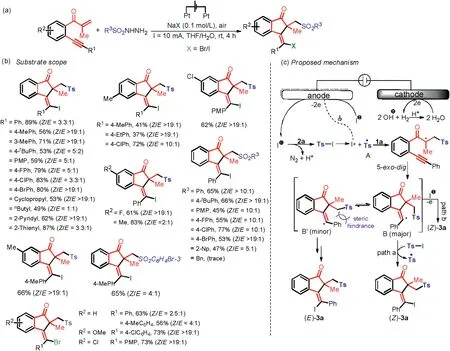Electrosynthesis of 1-indanones
2021-11-06JunJingZhengWngWeiMinHe
Jun Jing,Zheng Wng*,Wei-Min He,*
a School of Chemistry and Chemical Engineering, University of South China, Hengyang 421001, China
b Department of Chemistry and Bioengineering, Hunan University of Science and Engineering, Yongzhou 425199, China
ABSTRACT The recent electrocatalytic three-component annulation-halosulfonylation of 1,6-enynes toward 1-indanones is highlighted.
Keywords: Electrosynthesis Halosulfonylation 1,6-Enynes 1-Indanones
Radical-triggered cyclization cascade have proved to be efficient strategies for the direct assembly of bifunctional cyclic rings containing both isocyclic skeletons and heterocyclic.In this context,a large amount of unsaturated compounds endowed with alkene and/or alkyne units are devised and prepared as radical acceptors to catch the various radical species [1].Generally, the success of the radical cyclization with bifunctionalization depends on the continuous radical transfer via a synergistic orientation process across the unsaturated system.As a result,these substrates are needed to play dual roles as a radical donor and a radical acceptor, thereby offering undoubtedly powerful synthetic schemes for functionalized cyclic molecules.Recently, the synthesis of functionalized 1-indanones via radical triggered cyclization cascades of 1,6-eynes were developed, but relied on transition metal catalysts and/or stoichiometric oxidants [2].Therefore, it is still urgent to develop a catalyst-free and oxidantfree radical cyclization strategy to construct structurally important 1-indanones.
In the past few years, electrochemistry has emerged as an attractive method for organic chemists toward functional molecules owing to its green and sustainable characteristics [3].As an ideal alternative to chemical oxidants, electrochemical anodic oxidation indicates an environmentally friendly synthetic approach in organic chemistry.Consequently,combining metal-free electrochemistry with radical cyclization strategies is considered to be a prospective and environmental choice for accessing significant molecules in pharmaceutical industry and drug discovery [4].
By means of electrochemical strategy, very recently, the research group of Professor Shu-Jiang Tu and Bo Jiang from Jiangsu Normal University reported an impressive sulfonylation/halogenation via the radical cyclization with bifunctionalization of the 1,6-enynes with high stereoselectivity, avoiding the use of oxidants and metal catalyst (Scheme 1) [5].The authors firstly conceived that the sulfonyl radicals,from sulfonyl hydrazide in the presence of sodium halide with electric current,add into terminal C =C double bond of 1,6-enynes and subsequent 5-exo-dig cyclization forms the exocyclic vinyl radical intermediates,which would be trapped by halogen atom.Next, they made great effort to establish the following optimal conditions,namely the reaction of 1,6-enynes 1(0.2 mmol)with arylsulfonyl hydrazides 2(0.6 mmol,3.0 equiv.) in the presence of NaI (0.4 mmol) in the co-solvent of THF-H2O(4 mL,v/v=1/1)in an undivided cell using two platinum plates as the working electrode and cathode under 10 mA constant current for 4.0 h,and used to produce a wide range of 1-indanones 3 with good stereoselectvity (Scheme 1a).
In the substrate usability,it was found that both 1,6-enynes and arylsulfonyl hydrazides could be tolerated by changing their electronic properties and steric effects, affording the corresponding 1-indanones smoothly in the current electrocatalytic cyclization with moderate to good efficiency.Overall, 32 examples were successfully obtained, in which various substituents, including aryl, alicyclic and alkyl as well as heterocyclic groups, in the arylalkynyl moiety of 1,6-enynes 1 were all well-tolerated with this electrocatalytic system.Similarly, substituents in the internal arene ring of 1,6-enynes could participate in the current transformation.As anticipated, sodium bromide (NaBr) could be accommodated in the reaction,which behaves a similar reactivity profile as compared with sodium iodide(Scheme 1b).Notably,the high stereoselectivity was observed in the most of products and Z/E ratio was confirmed by1H NMR.More importantly, potassium iodide (or sodium bromide) plays the triple role of an electrolyte and a redox catalyst as well as an iodination reagent.

Scheme 1.Electrocatalytic three-component halosulfonylation for forming 1-indanones.
A reasonable mechanism was proposed in Scheme 1c.Initially,the anodic oxidation of the iodide ion forms I+species with the loss of two electrons, which reacts with arylsulfonyl hydrazide 2a to generate arylsulfonyl iodide intermediate.Subsequently, arylsulfonyl iodide spontaneously decomposes to give arylsulfonyl radical A and iodine radical.The latter would lose one electron to convert into iodonium I+by electric current.The aryl-sulfonyl radical A reacts with 1a, which undergoes 5-exo-dig cyclization to gives radical intermediate (E)-B as a major stereoisomer and (Z)-B'(minor)as a minor stereoisomer.Finally,intermediate(E)-B reacts with arylsulfonyl iodide or is oxidized by electric current,which is intercepted by iodide ion to give the product 3a.On the cathode,two protons were reduced to produce H2.
In summary,the group of Tu and Jiang has presented an efficient synthesis of 1-indanone derivatives via the electrochemical oxidative sulfonylation-halogenation(iodization and bromination)sequences of 1,6-enynes 1.The reaction equipped with platinum plate electrodes employing sodium halide as electrolyte, arylsulfonyl hydrazides as arylsulfonyl radical precursor under an undivided cell, avoiding the use of transition metal catalysts,oxidants and additives.Significantly, the method is attractive and environmentally friendly due to its mild reaction conditions,offering a facile way to prepare 1-indanone derivatives.
Declaration of competing interest
The authors report no declarations of interest.
杂志排行
Chinese Chemical Letters的其它文章
- Molecular recognition triggered aptazyme cascade for ultrasensitive detection of exosomes in clinical serum samples
- Current signal amplification strategies in aptamer-based electrochemical biosensor: A review
- Photo-crosslinkable hydrogel and its biological applications
- STING-activating drug delivery systems: Design strategies and biomedical applications
- The carbon nanotubes-based materials and their applications for organic pollutant removal: A critical review
- The application of clean production in organic synthesis
